Austro-Hungarian Assault Formations during World War I
By Christian Ortner
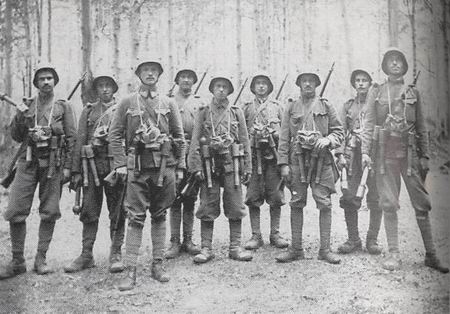 When the Austro-Hungarian army entered the war in July/August 1914, the units used the same battlefield tactics they had practiced during their peacetime manoeuvres. Based on the experiences of the Franco-Prussian war of 1870/71, the army's spirit was aimed at an offensive character. All tactical manuals were influenced by this spirit, always pointing at the assault or attack as the best solution in a tactical situation. Mainly the infantry, meant to be strong enough to take any objective, even without the support of artillery or cavalry, should do these attacks.
When the Austro-Hungarian army entered the war in July/August 1914, the units used the same battlefield tactics they had practiced during their peacetime manoeuvres. Based on the experiences of the Franco-Prussian war of 1870/71, the army's spirit was aimed at an offensive character. All tactical manuals were influenced by this spirit, always pointing at the assault or attack as the best solution in a tactical situation. Mainly the infantry, meant to be strong enough to take any objective, even without the support of artillery or cavalry, should do these attacks.
The big campaigns during summer and autumn 1914 in the northeast and southeast had been led in exactly that way. For the single regiment or battalion this kind of warfare meant always rushing forwards in the direction of estimated enemy positions. When the enemy's position was identified, he should be attacked immediately, even off the march without preparation. This type of attack was called "recontre". At the beginning the Austro-Hungarian (AH) forces did not realize that the Serbs and especially the Russians secured their main positions with strong outposts. During the fighting these outposts were mainly defeated and retreated. For the Austrians, this looked like victory and the units started to follow up. When they reached the main enemy position, the Austrian units were often in total disorder and suddenly
confronted with heavy machine gun and artillery fire. Now the support of own artillery would have been needed, but the "new" objective was mostly out of range. So the artillery started to move forward and changed position in exactly that moment, when the suffering attacking infantry needed shrapnel or shellfire most.
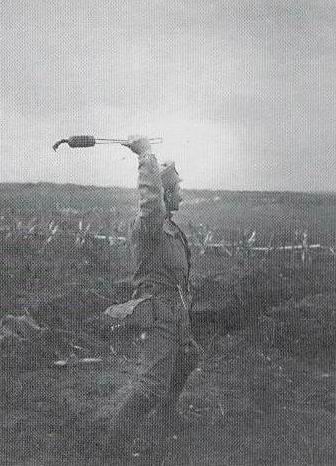 The worst thing for the individual soldier during this period was the fact that the enemy, the Russians often dug in already at the beginning of the war, could not be seen. The attacking forces now were fixed in front of the enemy's trenches, not able to move forward or retreat. The casualties were rising. During the winter of 1914/1915 the situation changed. Later than on the western front, both sides started to dig in systematically, put obstacles in front of the trenches and deployed artillery behind the main battle line. Normally only one trench-line was built, being of course the main objective of all offensive attempts. Where the enemy was able to break through, the defender was forced to withdraw whole sectors to prevent the collapse of the whole frontline. To avoid this problem, the Austro-Hungarian High army command (Armeeoberkommando - AOK) started, mainly influenced by experiences on the German western front, to reorganize the way in which AH forces were deployed. About 100 metres behind the first line another was built and at the same distance behind the second a third line was established. All three lines were also connected by communication and supply lines and named the so-called "first position" (1. Stellung). At a distance of two or three kilometres another position (2. Stellung), also consisting of three lines, was made. Behind the second position the main artillery was deployed. A third position was planned (mostly not fully constructed) at a distance of four to six kilometers. This kind of "linear" trench system of course changed battlefield tactics. Attacks could only be successful, when the supporting artillery was able to destroy the obstacles and trenches of the first position to enable the infantry to get into the enemy position. To effect a decisive breakthrough it was necessary to take also the second position, especially the artillery area behind. If not, the defender was able to barrage the enemy by artillery fire preventing him bringing support and reserves to the attacking units. They were suffering heavy casualties and mostly too weak to hold their taken objectives. Counter attacks by the defender normally threw the enemy back to the initial positions. If not, the defender simply changed the former second position to his new first one; the former third became the new second one.
The worst thing for the individual soldier during this period was the fact that the enemy, the Russians often dug in already at the beginning of the war, could not be seen. The attacking forces now were fixed in front of the enemy's trenches, not able to move forward or retreat. The casualties were rising. During the winter of 1914/1915 the situation changed. Later than on the western front, both sides started to dig in systematically, put obstacles in front of the trenches and deployed artillery behind the main battle line. Normally only one trench-line was built, being of course the main objective of all offensive attempts. Where the enemy was able to break through, the defender was forced to withdraw whole sectors to prevent the collapse of the whole frontline. To avoid this problem, the Austro-Hungarian High army command (Armeeoberkommando - AOK) started, mainly influenced by experiences on the German western front, to reorganize the way in which AH forces were deployed. About 100 metres behind the first line another was built and at the same distance behind the second a third line was established. All three lines were also connected by communication and supply lines and named the so-called "first position" (1. Stellung). At a distance of two or three kilometres another position (2. Stellung), also consisting of three lines, was made. Behind the second position the main artillery was deployed. A third position was planned (mostly not fully constructed) at a distance of four to six kilometers. This kind of "linear" trench system of course changed battlefield tactics. Attacks could only be successful, when the supporting artillery was able to destroy the obstacles and trenches of the first position to enable the infantry to get into the enemy position. To effect a decisive breakthrough it was necessary to take also the second position, especially the artillery area behind. If not, the defender was able to barrage the enemy by artillery fire preventing him bringing support and reserves to the attacking units. They were suffering heavy casualties and mostly too weak to hold their taken objectives. Counter attacks by the defender normally threw the enemy back to the initial positions. If not, the defender simply changed the former second position to his new first one; the former third became the new second one.
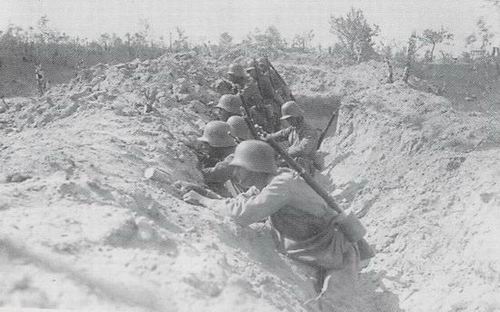 This procedure caused a need for mass artillery with plenty of ammunition, because two main targets had to be destroyed, the first and the second position. An attack had to be planned and prepared quite well, so on the Russian front long periods were rather quiet. Most of the fighting at this time was low intensity fights, consisting of patrols trying to take enemy outposts or fighting each other in no-man's-land. The Russian army had at this time specially trained soldiers, so called "Jagdkommandos", formed in 1886, to perform reconnaissance at the regimental level. These commandos had been very successful executing strikes against Austrian positions, always causing casualties and serious damage to morale. To protect them-selves against ambushes and sudden strikes, AH infantry and cavalry (no longer mounted at this time) regiments doing service in the first position formed "Jagdkommandos" themselves. They simply copied the Russian idea. There was no order by the AOK to establish such special forces, but they were raised. In some areas the number of commandos was rising very quickly. The engagements of these commando squads have been described in literature very romantically, but in fact it was of course a hard job and very dangerous.
This procedure caused a need for mass artillery with plenty of ammunition, because two main targets had to be destroyed, the first and the second position. An attack had to be planned and prepared quite well, so on the Russian front long periods were rather quiet. Most of the fighting at this time was low intensity fights, consisting of patrols trying to take enemy outposts or fighting each other in no-man's-land. The Russian army had at this time specially trained soldiers, so called "Jagdkommandos", formed in 1886, to perform reconnaissance at the regimental level. These commandos had been very successful executing strikes against Austrian positions, always causing casualties and serious damage to morale. To protect them-selves against ambushes and sudden strikes, AH infantry and cavalry (no longer mounted at this time) regiments doing service in the first position formed "Jagdkommandos" themselves. They simply copied the Russian idea. There was no order by the AOK to establish such special forces, but they were raised. In some areas the number of commandos was rising very quickly. The engagements of these commando squads have been described in literature very romantically, but in fact it was of course a hard job and very dangerous.
On the western front, trench warfare started already in 1914. Both sides realized, that - following the old infantry-tactics -, enemy positions couldn't be taken any more. German local commanders developed new tactics based on combat patrols (Stoßtrupps). They were armed with light machine guns, hand-grenades and wire cutters. Their mission was to cross no man's land between the trenches, get into the first enemy trench and clear it in close combat. Later on, their mission changed and was concentrated only on removing the obstacles to effect a passage for the following infantry.
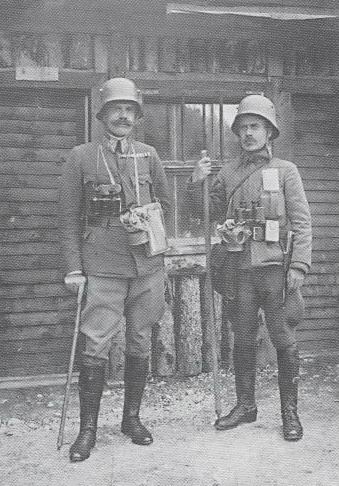 This meant, that the soldiers doing service in these combat patrols should be trained on the one hand as infantrymen and on the other as engineers concerning the clearing of the obstacle-zone. In March 1915 the first special detachment was activated, consisting of two engineer companies and a 37 mm gun section. After the commander, the detachment was called "Sturmabteilung Calsow". The experiences were rather unsuccessful, because the higher commands didn't know what to do with these special forces. So they were deployed as normal infantrymen. The situation changed, when Hauptmann E. Rohr took over the command in June 1915. He reorganized the detachment, now consisting of two engineer companies, a 37 mm gun section, a machine gun platoon (6 MGs), a mortar squad (4 small mortars) and a flamethrower squad. In March 1916 the detachments general orders were fixed in the follow-ing way. Only 50 % of the detachment was to do service in the frontline, the rest had to carry out courses to train the regular infantry in special assault tactics. The courses took place in Beuville and lasted 14 days. By and by the detachment "Rohr" was growing. Another two infantry companies were incorporated, so Rohr's unit was no longer a detachment, but a full battalion, named "Assault battalion Rohr". By and by all German armies raised assault battalions to train their officers and soldiers in assault tactics and trench warfare. All together, 17 German assault battalions were activated during WW I.
This meant, that the soldiers doing service in these combat patrols should be trained on the one hand as infantrymen and on the other as engineers concerning the clearing of the obstacle-zone. In March 1915 the first special detachment was activated, consisting of two engineer companies and a 37 mm gun section. After the commander, the detachment was called "Sturmabteilung Calsow". The experiences were rather unsuccessful, because the higher commands didn't know what to do with these special forces. So they were deployed as normal infantrymen. The situation changed, when Hauptmann E. Rohr took over the command in June 1915. He reorganized the detachment, now consisting of two engineer companies, a 37 mm gun section, a machine gun platoon (6 MGs), a mortar squad (4 small mortars) and a flamethrower squad. In March 1916 the detachments general orders were fixed in the follow-ing way. Only 50 % of the detachment was to do service in the frontline, the rest had to carry out courses to train the regular infantry in special assault tactics. The courses took place in Beuville and lasted 14 days. By and by the detachment "Rohr" was growing. Another two infantry companies were incorporated, so Rohr's unit was no longer a detachment, but a full battalion, named "Assault battalion Rohr". By and by all German armies raised assault battalions to train their officers and soldiers in assault tactics and trench warfare. All together, 17 German assault battalions were activated during WW I.
The AOK had also realised, that there was a strong need to intensify infantry training. Every army should establish a special training ground, where experienced soldiers could educate young recruits in the peculiarities of modern trench warfare. When the AOK noticed, that the Germans had already developed such courses, the German High command was asked, if it was possible to join one course in Beuville. 15 officers of the AH army attended two courses in September / October 1916. The experiences were rather positive, so the AOK asked again to send soldiers to Beuville. The German High command offered, to activate three courses (November 1916, December 1916, January 1917) only for members of the AH army. 120 officers and 300 NCOs were trained in Beuville. Copying the German system, they should be the main cadre of the newly raised AH army assault battalions. These army assault battalions had to train until spring 1917 at least two assault squads ("Sturmpatrouillen") per every infantry company. The composition of these army assault battalions differed due to the available resources in the army area. Normally there were 4 infantry companies, a MG-company, mortars, flamethrowers and engineer squads. The training was rather successful on the north-eastern front, because the low fighting intensity offered enough possibilities to take soldiers out of the front line and send them to the courses. On the other hand, the former "Jagdkommandos" simply changed their designation and were incorporated into these battalions. On the Italian front there were more problems, especially because of the heavy casualties on the Isonzo sector. Regimental commanders often refused to send their best men to the hinterland just for training
purposes.
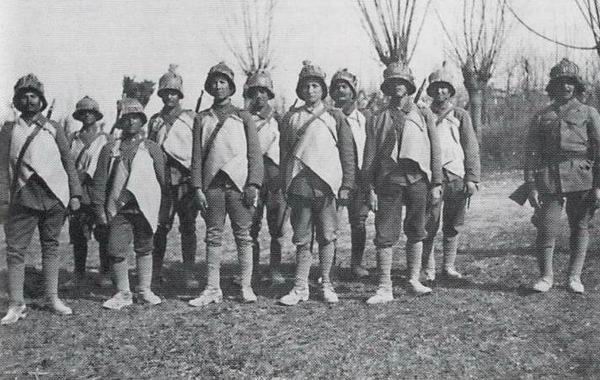 The first test for this young infantry branch was made during the 10th battle of the Isonzo-river. The experiences differed. When the assault companies were split up into squads, being at the head of the infantry in a counter attack, the fighting was always successful. Where they deployed in close formation, the companies suffered heavy casualties, also if there had been no reconnaissance on the objective. Because of this, the AOK developed general orders on how to deploy assault battalions in the future. The composition of the battalions was also fixed. In contrast with the period before and the German system, assault battalions should, be-ginning from June 1917, be raised at the divisional level. Every infantry division should have a divisional assault battalion consisting of as many assault companies as the division had regiments. Every cavalry division had to activate a so-called assault half-regiment. Independent brigades had to raise half-battalions. The number-designation of the assault battalions, half-regiments or half-battalions was the same as the parent divisions/brigade. The companies received the number of their regiment, for instance: k.u.k. Infantry regiment Nr. 14 - k.u.k. Assault Company Nr.
14.
The first test for this young infantry branch was made during the 10th battle of the Isonzo-river. The experiences differed. When the assault companies were split up into squads, being at the head of the infantry in a counter attack, the fighting was always successful. Where they deployed in close formation, the companies suffered heavy casualties, also if there had been no reconnaissance on the objective. Because of this, the AOK developed general orders on how to deploy assault battalions in the future. The composition of the battalions was also fixed. In contrast with the period before and the German system, assault battalions should, be-ginning from June 1917, be raised at the divisional level. Every infantry division should have a divisional assault battalion consisting of as many assault companies as the division had regiments. Every cavalry division had to activate a so-called assault half-regiment. Independent brigades had to raise half-battalions. The number-designation of the assault battalions, half-regiments or half-battalions was the same as the parent divisions/brigade. The companies received the number of their regiment, for instance: k.u.k. Infantry regiment Nr. 14 - k.u.k. Assault Company Nr.
14.
Concerning the supporting elements many problems had to be faced. In addition to the assault companies, the battalions should consist of a MG-company, an infantry-gun-section, a mortar platoon, a flamethrower platoon and a phone-squad. Because of the shortage of weapons and war material, these units were taken out of the front regiments and had to be returned immediately after the courses or missions. It can be said, that until October 1917 most of the assault battalions had no own support elements. In that case the big victory of the joint AH and Ger-man forces during the 12th battle of Isonzo was decisive for the assault battalions. Much Italian war material and weapons had been captured and were now issued to the assault-troopers. During their training, the soldiers of the assault detachments had always been instructed on enemy weapons, ready to use seized enemy equipment for their own purposes after taking an objective. Now they got plenty of MGs or SMGs, which could be used
immediately.
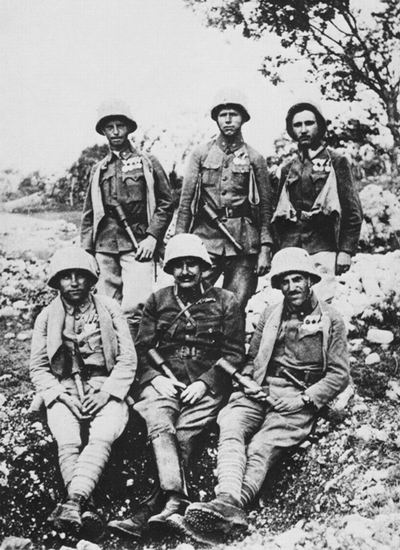 During the 12th Isonzo-battle, the AH assault-battalions proved their efficiency during modern trench warfare. Their elite character was similar to the pre-war role of the cavalry. Storm troopers became a symbol of offensive spirit and successful attacks, but led - by the way - to an overestimation of their power to effectively decide the issue on the battlefield. Until June 1918 the AH army had quite a lot of storm troopers at her disposal. Every front-company had at least two assault patrols, ready to perform reconnaissance or special missions on enemy outposts. Secondly there were the regimental assault companies forming the divisional battalions and third the well equipped staff of the army assault
courses.
During the 12th Isonzo-battle, the AH assault-battalions proved their efficiency during modern trench warfare. Their elite character was similar to the pre-war role of the cavalry. Storm troopers became a symbol of offensive spirit and successful attacks, but led - by the way - to an overestimation of their power to effectively decide the issue on the battlefield. Until June 1918 the AH army had quite a lot of storm troopers at her disposal. Every front-company had at least two assault patrols, ready to perform reconnaissance or special missions on enemy outposts. Secondly there were the regimental assault companies forming the divisional battalions and third the well equipped staff of the army assault
courses.
But from 1918 the system of building the trenches changed. Instead of the 1st, 2nd and 3rd position, combat zones were established. The first and second positions have been brought together to the "main combat zone", about 4 km deep. It was secured to the front by an outpost line. Bunkers, camouflaged MGs, deep obstacle-areas, hidden infantry-guns and mortars fortified the distance between the former first and second position. This meant, during an attack not only lines had to be taken, but the infantry had to break through the whole combat-zone. Despite the large number of available combat patrols, they were simply not enough to take all the objectives in the combat-zone. This was one of the causes, why the offensive on the Piave River in June 1918 failed.
After this battle, all assault units and patrols were taken out of the front and returned to their trainings camps. Their service was reduced to reconnaissance and small assault missions until the end of the war. After the war, the idea of specially trained and equipped assault troops was given up. It was planned to train every soldier in close combat and trench warfare, so there was no need to keep any assault units. Like the whole AH army, the assault-battalions disappeared in November 1918. But it was their skills, their training and their efficiency, which
moulded infantry organization and training of the European armies of WW II.
Back to Troops and Unit
Histories

Created and Copyright ©
M C Ortner 2002
 When the Austro-Hungarian army entered the war in July/August 1914, the units used the same battlefield tactics they had practiced during their peacetime manoeuvres. Based on the experiences of the Franco-Prussian war of 1870/71, the army's spirit was aimed at an offensive character. All tactical manuals were influenced by this spirit, always pointing at the assault or attack as the best solution in a tactical situation. Mainly the infantry, meant to be strong enough to take any objective, even without the support of artillery or cavalry, should do these attacks.
When the Austro-Hungarian army entered the war in July/August 1914, the units used the same battlefield tactics they had practiced during their peacetime manoeuvres. Based on the experiences of the Franco-Prussian war of 1870/71, the army's spirit was aimed at an offensive character. All tactical manuals were influenced by this spirit, always pointing at the assault or attack as the best solution in a tactical situation. Mainly the infantry, meant to be strong enough to take any objective, even without the support of artillery or cavalry, should do these attacks.
 The worst thing for the individual soldier during this period was the fact that the enemy, the Russians often dug in already at the beginning of the war, could not be seen. The attacking forces now were fixed in front of the enemy's trenches, not able to move forward or retreat. The casualties were rising. During the winter of 1914/1915 the situation changed. Later than on the western front, both sides started to dig in systematically, put obstacles in front of the trenches and deployed artillery behind the main battle line. Normally only one trench-line was built, being of course the main objective of all offensive attempts. Where the enemy was able to break through, the defender was forced to withdraw whole sectors to prevent the collapse of the whole frontline. To avoid this problem, the Austro-Hungarian High army command (Armeeoberkommando - AOK) started, mainly influenced by experiences on the German western front, to reorganize the way in which AH forces were deployed. About 100 metres behind the first line another was built and at the same distance behind the second a third line was established. All three lines were also connected by communication and supply lines and named the so-called "first position" (1. Stellung). At a distance of two or three kilometres another position (2. Stellung), also consisting of three lines, was made. Behind the second position the main artillery was deployed. A third position was planned (mostly not fully constructed) at a distance of four to six kilometers. This kind of "linear" trench system of course changed battlefield tactics. Attacks could only be successful, when the supporting artillery was able to destroy the obstacles and trenches of the first position to enable the infantry to get into the enemy position. To effect a decisive breakthrough it was necessary to take also the second position, especially the artillery area behind. If not, the defender was able to barrage the enemy by artillery fire preventing him bringing support and reserves to the attacking units. They were suffering heavy casualties and mostly too weak to hold their taken objectives. Counter attacks by the defender normally threw the enemy back to the initial positions. If not, the defender simply changed the former second position to his new first one; the former third became the new second one.
The worst thing for the individual soldier during this period was the fact that the enemy, the Russians often dug in already at the beginning of the war, could not be seen. The attacking forces now were fixed in front of the enemy's trenches, not able to move forward or retreat. The casualties were rising. During the winter of 1914/1915 the situation changed. Later than on the western front, both sides started to dig in systematically, put obstacles in front of the trenches and deployed artillery behind the main battle line. Normally only one trench-line was built, being of course the main objective of all offensive attempts. Where the enemy was able to break through, the defender was forced to withdraw whole sectors to prevent the collapse of the whole frontline. To avoid this problem, the Austro-Hungarian High army command (Armeeoberkommando - AOK) started, mainly influenced by experiences on the German western front, to reorganize the way in which AH forces were deployed. About 100 metres behind the first line another was built and at the same distance behind the second a third line was established. All three lines were also connected by communication and supply lines and named the so-called "first position" (1. Stellung). At a distance of two or three kilometres another position (2. Stellung), also consisting of three lines, was made. Behind the second position the main artillery was deployed. A third position was planned (mostly not fully constructed) at a distance of four to six kilometers. This kind of "linear" trench system of course changed battlefield tactics. Attacks could only be successful, when the supporting artillery was able to destroy the obstacles and trenches of the first position to enable the infantry to get into the enemy position. To effect a decisive breakthrough it was necessary to take also the second position, especially the artillery area behind. If not, the defender was able to barrage the enemy by artillery fire preventing him bringing support and reserves to the attacking units. They were suffering heavy casualties and mostly too weak to hold their taken objectives. Counter attacks by the defender normally threw the enemy back to the initial positions. If not, the defender simply changed the former second position to his new first one; the former third became the new second one.  This procedure caused a need for mass artillery with plenty of ammunition, because two main targets had to be destroyed, the first and the second position. An attack had to be planned and prepared quite well, so on the Russian front long periods were rather quiet. Most of the fighting at this time was low intensity fights, consisting of patrols trying to take enemy outposts or fighting each other in no-man's-land. The Russian army had at this time specially trained soldiers, so called "Jagdkommandos", formed in 1886, to perform reconnaissance at the regimental level. These commandos had been very successful executing strikes against Austrian positions, always causing casualties and serious damage to morale. To protect them-selves against ambushes and sudden strikes, AH infantry and cavalry (no longer mounted at this time) regiments doing service in the first position formed "Jagdkommandos" themselves. They simply copied the Russian idea. There was no order by the AOK to establish such special forces, but they were raised. In some areas the number of commandos was rising very quickly. The engagements of these commando squads have been described in literature very romantically, but in fact it was of course a hard job and very dangerous.
This procedure caused a need for mass artillery with plenty of ammunition, because two main targets had to be destroyed, the first and the second position. An attack had to be planned and prepared quite well, so on the Russian front long periods were rather quiet. Most of the fighting at this time was low intensity fights, consisting of patrols trying to take enemy outposts or fighting each other in no-man's-land. The Russian army had at this time specially trained soldiers, so called "Jagdkommandos", formed in 1886, to perform reconnaissance at the regimental level. These commandos had been very successful executing strikes against Austrian positions, always causing casualties and serious damage to morale. To protect them-selves against ambushes and sudden strikes, AH infantry and cavalry (no longer mounted at this time) regiments doing service in the first position formed "Jagdkommandos" themselves. They simply copied the Russian idea. There was no order by the AOK to establish such special forces, but they were raised. In some areas the number of commandos was rising very quickly. The engagements of these commando squads have been described in literature very romantically, but in fact it was of course a hard job and very dangerous.  This meant, that the soldiers doing service in these combat patrols should be trained on the one hand as infantrymen and on the other as engineers concerning the clearing of the obstacle-zone. In March 1915 the first special detachment was activated, consisting of two engineer companies and a 37 mm gun section. After the commander, the detachment was called "Sturmabteilung Calsow". The experiences were rather unsuccessful, because the higher commands didn't know what to do with these special forces. So they were deployed as normal infantrymen. The situation changed, when Hauptmann E. Rohr took over the command in June 1915. He reorganized the detachment, now consisting of two engineer companies, a 37 mm gun section, a machine gun platoon (6 MGs), a mortar squad (4 small mortars) and a flamethrower squad. In March 1916 the detachments general orders were fixed in the follow-ing way. Only 50 % of the detachment was to do service in the frontline, the rest had to carry out courses to train the regular infantry in special assault tactics. The courses took place in Beuville and lasted 14 days. By and by the detachment "Rohr" was growing. Another two infantry companies were incorporated, so Rohr's unit was no longer a detachment, but a full battalion, named "Assault battalion Rohr". By and by all German armies raised assault battalions to train their officers and soldiers in assault tactics and trench warfare. All together, 17 German assault battalions were activated during WW I.
This meant, that the soldiers doing service in these combat patrols should be trained on the one hand as infantrymen and on the other as engineers concerning the clearing of the obstacle-zone. In March 1915 the first special detachment was activated, consisting of two engineer companies and a 37 mm gun section. After the commander, the detachment was called "Sturmabteilung Calsow". The experiences were rather unsuccessful, because the higher commands didn't know what to do with these special forces. So they were deployed as normal infantrymen. The situation changed, when Hauptmann E. Rohr took over the command in June 1915. He reorganized the detachment, now consisting of two engineer companies, a 37 mm gun section, a machine gun platoon (6 MGs), a mortar squad (4 small mortars) and a flamethrower squad. In March 1916 the detachments general orders were fixed in the follow-ing way. Only 50 % of the detachment was to do service in the frontline, the rest had to carry out courses to train the regular infantry in special assault tactics. The courses took place in Beuville and lasted 14 days. By and by the detachment "Rohr" was growing. Another two infantry companies were incorporated, so Rohr's unit was no longer a detachment, but a full battalion, named "Assault battalion Rohr". By and by all German armies raised assault battalions to train their officers and soldiers in assault tactics and trench warfare. All together, 17 German assault battalions were activated during WW I.  During the 12th Isonzo-battle, the AH assault-battalions proved their efficiency during modern trench warfare. Their elite character was similar to the pre-war role of the cavalry. Storm troopers became a symbol of offensive spirit and successful attacks, but led - by the way - to an overestimation of their power to effectively decide the issue on the battlefield. Until June 1918 the AH army had quite a lot of storm troopers at her disposal. Every front-company had at least two assault patrols, ready to perform reconnaissance or special missions on enemy outposts. Secondly there were the regimental assault companies forming the divisional battalions and third the well equipped staff of the army assault
courses.
During the 12th Isonzo-battle, the AH assault-battalions proved their efficiency during modern trench warfare. Their elite character was similar to the pre-war role of the cavalry. Storm troopers became a symbol of offensive spirit and successful attacks, but led - by the way - to an overestimation of their power to effectively decide the issue on the battlefield. Until June 1918 the AH army had quite a lot of storm troopers at her disposal. Every front-company had at least two assault patrols, ready to perform reconnaissance or special missions on enemy outposts. Secondly there were the regimental assault companies forming the divisional battalions and third the well equipped staff of the army assault
courses.